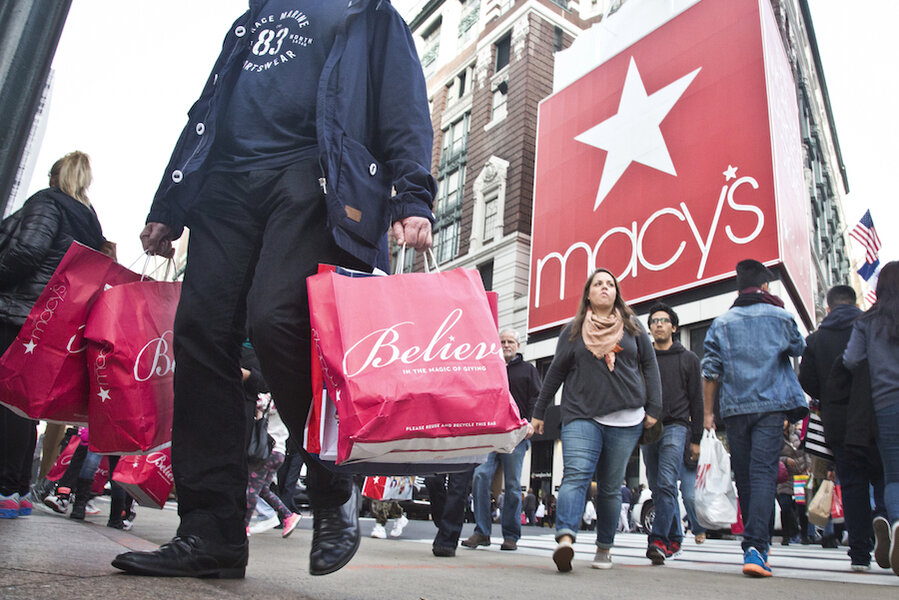Despite hard times for Macy’s and Sears, physical retail stores are booming
Loading...
The past year has been brutal for some brick-and-mortar retailers.
Once popular chains including Sports Authority and Aeropostale went bankrupt. Gap saw dismal sales, as the icon of American casual wear continued a years-long decline. On Wednesday, Macy’s and Sears, once the kings of the department store era, announced lackluster sales and store closings. Sears Holdings announced it will close 108 Kmart and 42 Sears stores over the next few months. Macy's announced the locations of 68 of the 100 stores it plans to close, with some 10,000 jobs lost.
When considered alongside the booming online retail business led by Amazon, these struggling retailers appear to portend a bleak future for real-life stores. Yet, the brick-and-mortar business is actually growing in some segments, as some American retailers ready for a future that looks more interactive, digital, and discounted.
Fast-fashion clothiers that offer the latest trends at really low cost, such as H&M and Zara, have been wildly popular with Millennials for years (though some industry watchers warn that their sales are slowing). T.J. Maxx, Nordstrom Rack, Burlington Coat Factory, and Ross, which sell discounted designer clothes and home goods, are also growing. “In fact, they’re growing like gangbusters,” says Michelle Grant, head of retail at Euromonitor International, a global market research firm.
These discount stores, such as T.J. Maxx, globally are growing by an average 7 percent annually, says Ms. Grant, well above the 2 percent yearly growth for retail overall.
While the days of immense department stores may be winding down, in the grand scheme of shopping, physical stores are still important. Online retail giant Amazon, for example, has been experimenting with physical stores lately, opening shops in Seattle, Portland, and San Diego, with another one planned for New York City later this year. Brick-and-mortar stores likely will play a part in the future of shopping that will blend offline, online, and mobile retail to make buying fun and convenient.
“These stores are becoming a place for experiential shopping versus transactional,” is the way Euromonitor describes this trend in a recent report on unique retail concepts globally.
A real-life example of this idea is Amazon’s new grocery store, Amazon Go, opening in Seattle this year. It uses advanced technology to simplify the shopping experience. Amazon plans to allow customers to scan an app as they walk into the store, freely take food off the shelves, and leave with their groceries without the traditional process of going through a checkout line. Instead, shoppers will be charged for whatever they take with them, via the app.
Similarly, Wal-Mart, though it planned to close 154 stores in the US in 2016, bought Jet.com last year, a year-old e-commerce discount store, The retailer also has been experimenting with allowing customers to buy groceries online first and then picking up their purchases at retail stores.
The makeup chain Sephora, a private company which Ms. Grant says has “some of the highest margins in the business,” has an app that allows customers to virtually try on eyeliner and lipstick before they buy it, and will be introducing in-store mirrors that will offer the same option. The company also offers a plethora of beauty classes and other services at its stores to keep customers engaged with the brand, though the buying doesn't need to happen there.
And Bonobos, a men’s clothing maker that started out as an online-only business, now has physical stores in some cities. But Bonobos doesn’t stock merchandise that customers can buy at those locations. Instead, shoppers can come in to try on clothes with the help of in-store staff and then make purchase through an iPad at the store to have them shipped home or to work for free.
“I really thought stores were going away...,” Bonobos CEO Andy Dunn told The Chicago Tribune in April 2016, referring to his state of mind in 2007, when the company first launched. But it appears that online retail cannot live without real-life stores just yet.








